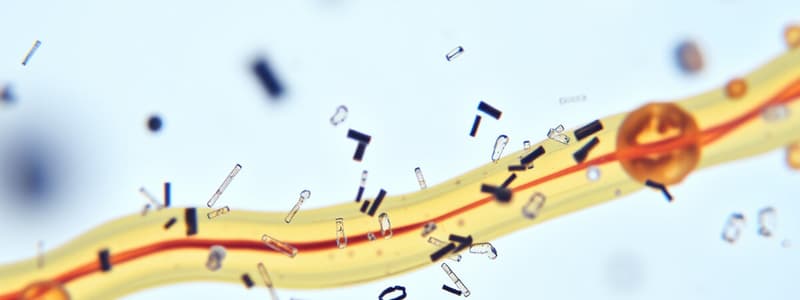Podcast
Questions and Answers
What is microbiology?
What is microbiology?
- The study of plants
- The study of microorganisms (correct)
- The study of animals
- The study of the environment
What is the primary function of microscopes?
What is the primary function of microscopes?
To visualize objects too small for us to see.
Which of the following types of microscopes is categorized under low, mid, and very high-power magnification?
Which of the following types of microscopes is categorized under low, mid, and very high-power magnification?
- Ocular lens
- Hand-held microscope (correct)
- Compound light microscope (correct)
- Electron microscope (correct)
What does magnification refer to in the context of microscopes?
What does magnification refer to in the context of microscopes?
What is resolving power?
What is resolving power?
What is meant by 'microns'?
What is meant by 'microns'?
Which type of microscope is the most common?
Which type of microscope is the most common?
Match the following lenses with their positions:
Match the following lenses with their positions:
What is the purpose of the diaphragm in a microscope?
What is the purpose of the diaphragm in a microscope?
What is the purpose of an oil immersion lens?
What is the purpose of an oil immersion lens?
Always carry a microscope with one hand securely around the arm and the other underneath the ______
Always carry a microscope with one hand securely around the arm and the other underneath the ______
What should you do first when using a microscope?
What should you do first when using a microscope?
The ______ adjustment knob is used to obtain precise focus on the specimen.
The ______ adjustment knob is used to obtain precise focus on the specimen.
What should you always do when switching to the high-power lens?
What should you always do when switching to the high-power lens?
Flashcards are hidden until you start studying
Study Notes
Microscope Basics
- Microbiology focuses on the study of microorganisms.
- Microscopes are essential tools for visualizing objects that are too small to be seen with the naked eye.
Types of Microscopes
- Low-level magnification: Handheld microphones for basic use.
- Mid-level magnification: Compound light microscopes, commonly used in labs.
- Very high-power magnification: Electron microscopes, offering the highest resolution.
Key Characteristics
- Magnification and resolving power are critical factors in selecting a microscope.
- Resolving power is the ability to distinguish fine details; shorter wavelengths yield higher resolution.
Measurements
- Microns measure cellular dimensions, equivalent to one-millionth of a meter.
Common Microscopes
- The compound light microscope is the most widely used type.
- Ocular lenses (viewing lenses) and objective lenses (closer to the specimen) collaborate to magnify the sample.
Components of a Compound Microscope
- Base: Provides stability.
- Light source: Illuminates the specimen.
- Stage: Supports slides for viewing.
- Diaphragm: Adjusts light intensity on the specimen.
- Stage clips: Secure the slides in position.
- Revolving nosepiece: Allows switching between different objective lenses.
- Arm: Connects the base and head, used for carrying.
- Head: Houses ocular and revolving lenses.
Oil Immersion Lens
- An oil immersion lens, specifically the 100X objective, achieves maximum light microscope magnification.
- Requires oil to prevent light scattering, which can lower image quality.
Microscope Usage Protocol
- Always carry microscopes supporting the arm and base.
- Set up in well-lit areas and avoid using paper towels on lenses; use lens paper instead.
- Start with the scanning power objective lens when viewing specimens.
- Position the slide on the stage and secure it with clips, centering the specimen.
- Use the course adjustment knob to bring the slide into focus, followed by the fine adjustment knob for detail.
- Adjust the diaphragm to optimize light without washing out the image.
- Rotate to higher power lenses gradually, only using fine adjustment for high power.
- After use, return to scanning power before slide removal to protect lenses.
Studying That Suits You
Use AI to generate personalized quizzes and flashcards to suit your learning preferences.



